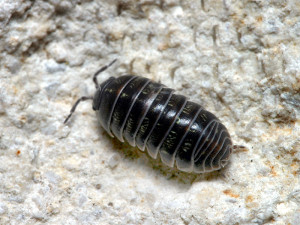
Pillbugs are semi-aquatic organisms that breath via gills. No wonder they seem to love this rainy weather.
Is it just me, or are we in the midst of a roly poly invasion? Now, I tend to not “see” some of the same pests other people see, because they just don’t bother me. I’ll look right past a spider in the house, because it’s just doing its thing. Similarly, I don’t tend to notice roly polies, also called pillbugs, because I’m so used to them living in the heaping piles of mulch around my home.
The past month, however, working on my lawn and landscape, even I have noticed the pillbugs. They are everywhere… BY THE MILLIONS. While I know to expect pillbugs in my garden mulch, I don’t believe I have ever seen so many pillbugs in the grass of my lawn.
So what’s going on here? Pillbugs are isopods, a type of Crustacean, and only a few evolutionary steps away from the water. In fact, pillbugs and sowbugs breath, like their aquatic cousins, through gills, and do especially well in wet environments. They are also one of the few arthropods that have the ability to eat and digest cellulose. It appears that with our unusually wet Texas spring, pillbugs have everything they need.

Pillbugs feeding on vinca. When numerous, pillbugs can do significant damage to young garden plants. Photo by D.W. Reed.
I wouldn’t mind pillbugs so much if they confined themselves to feeding on mulch (even if I curse them a little every spring when I have to re-mulch our landscape beds). But when numerous as they are right now, pillbugs are not shy about feeding on roots and tender stems of garden flowers and vegetables. In the past week I’ve watched my proud double row of green onions fall like dominoes, chewed at the base by hungry pillbugs.
I suppose some of this is our own fault. With the increased use of garden mulch and wood chips in recent years, we’ve provided lots of food for pillbugs. In yards hard hit by drought and disease and winter cold, there is plenty of food in the form of thatch and new growth to keep pillbugs happy.
While there’s little we can do to stop the rain, there may be a few steps we can take to discourage pill bugs. Avoid putting too much mulch in your garden. A four-inch layer is generally sufficient for insulation and water retention, anything over that will serve to attract and feed more pillbugs. Keep mulch away from the foundation of your home by 6 to 12 inches. If you are planning to mulch, keep your initial layers thin (enough to hold the soil) until we see some drier weather. You can always add more later, and your garden does not need the mulch as much when it’s wet anyway.
If planting new flowers or vegetables, consider treating the planting bed first with a liquid insecticide like permethrin, labeled for garden use. Newly emerged plants may need a protective spray every week or so. When treating vegetables, just make sure to allow enough time between last application and harvest, according to label instructions.
For more information about pillbugs, see http://citybugs.tamu.edu/factsheets/landscape/veggie/ent-1006/
